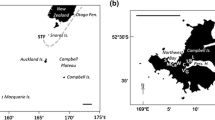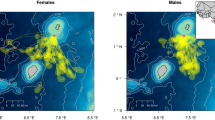Abstract
Skuas are top predator and scavenger seabirds in marine and terrestrial ecosystems and monitoring their diet can provide valuable insights on the abundance and distribution of prey. The diet of the brown skua was studied at Mayes Island, Kerguelen archipelago, by collection of prey remains during their breeding cycle in 2013. We investigated a potential diet shift by comparing our results to those obtained two decades ago at the same colony. Our results confirmed the high specialisation of this skua colony in active predation of two burrowing petrels: the blue petrel and the thin-billed prion. We observed a shift in the diet of the brown skua with the importance of the thin-billed prion dropping significantly by 15%. Concomitantly, we observed a decreasing trend of burrow occupancy of the two main preys, with a more severe decline for the thin-billed prion. We suspected a dietary shift of brown skuas at Mayes Island related to a change in the relative abundance of blue petrels and thin-billed prions. Diet of brown skuas appears to be a valuable indicator of the relative abundance of burrowing petrels when they constitute the main food resource during breeding.


adapted from Mougeot et al. 1998). Grey colours, from very light to very dark, correspond, respectively, to the prelaying period, the incubation period and the chick rearing period


Similar content being viewed by others
References
Adams NJ (1982) Subantarctic Skua prey remains as an aid for rapidly assessing the status of burrowing petrels at Prince Edward Island. Mar Ornithol 10:97–102
Andersson M (1976) Population ecology of the long-tailed skua (Stercorarius longicaudus Vieill.). J Anim Ecol 45:537–559
Anderson ORJ, Phillips RA, Shore RF et al (2009) Diet, individual specialisation and breeding of brown skuas (Catharacta antarctica lonnbergi): an investigation using stable isotopes. Polar Biol 32:27–33
Barbraud C, Delord K (2006) Population census of blue petrels Halobaena caerulea at Mayes Island, Iles Kerguelen. Antarct Sci 18:199–204
Barbraud C, Weimerskirch H (2003) Climate and density shape population dynamics of a marine top predator. Proc R Soc Lond B Biol Sci 270:2111–2116
Barbraud C, Marteau C, Ridoux V et al (2008) Demographic response of a population of whit-chinned petrels Procellaria aequinoctialis to climate and longline fishery bycatch. J Appl Ecol 45:1460–1467
Blévin P, Carravieri A, Jaeger A et al (2013) Wide range of mercury contamination in chicks of Southern Ocean seabirds. PLoS ONE 8:e54508
Bried J, Jouventin P (2001) Site and mate choice in seabirds; an evolutionary approach. In: Schreiber EA, Burger J (eds) Biology of marine birds. CRC Press, Boca Raton, pp 263–305
Brooke MDL, O’Connell TC, Wingate D et al (2010) Potential for rat predation to cause decline of the globally threatened Henderson petrel Pterodroma atrata: evidence from the field, stable isotopes and population modelling. Endanger Species Res 11:47–59
Carlos CJ (2016) How many genera of Stercorariidae are there? Rev Bras Ornitol Braz J Ornithol 24:191–195
Carneiro AP, Manica A, Trivelpiece WZ, Phillips RA (2015) Flexibility in foraging strategies of Brown Skuas in response to local and seasonal dietary constraints. J Ornithol 156(3):625–633
Cerfonteyn M, Ryan PG (2016) Have burrowing petrels recovered on Marion Island two decades after cats were eradicated? Evidence from sub-Antarctic skua prey remains. Antarct Sci 28:51–57
Croxall JP, Reid K, Prince PA (1999) Diet, provisioning and productivity responses of marine predators to differences in availability of Antarctic krill. Mar Ecol Prog Ser 177:115–131
Dell’Arte GL, Laaksonen T, Norrdahl K, Korpimäki E (2007) Variation in the diet composition of a generalist predator, the red fox, in relation to season and density of main prey. Acta Oecol 31:276–281
Delord K, Cherel Y, Barbraud C et al (2018) High variability in migration and wintering strategies of brown skuas (Catharacta antarctica lonnbergi) in the Indian Ocean. Polar Biol 41:59–70
Dilley BJ, Schramm M, Ryan PG (2017) Modest increases in densities of burrow-nesting petrels following the removal of cats (Felis catus) from Marion Island. Polar Biol 40:625–637
Fraser MW (1984) Foods of subantarctic skuas on Inaccessible Island. Ostrich 55:192–195
Furness RW (1987) The Skuas. T. & A. D Poyser, Calton
Furness RW, Camphuysen K (1997) Seabirds as monitors of the marine environment. IceS J Mar Sci 54:726–737
Furness RW, Tasker ML (2000) Seabird-fishery interactions: quantifying the sensitivity of seabirds to reductions in sandeel abundance, and identification of key areas for sensitive seabirds in the North Sea. Mar Ecol Prog Ser 202:253–264
Garrott RA, Bruggeman JE, Becker MS et al (2007) Evaluating prey switching in wolf–ungulate systems. Ecol Appl 17:1588–1597
Genevois F, Buffard E (1994) Sites de nidification et caractéristiques des terriers chez deux espèces de pétrels sympatriques aux Iles Kerguelen: le pétrel bleu Halobaena caerulea et le prion de Belcher Pachyptila belcheri. Alauda 62:123–134
Hahn S, Peter H-U (2003) Feeding territoriality and the reproductive consequences in brown skuas Catharacta antarctica lonnbergi. Polar Biol 26:552–559. https://doi.org/10.1007/s00300-003-0522-z
Hamer KC, Furness RW, Caldow RWG (1991) The effects of changes in food availability on the breeding ecology of great skuas Catharacta skua in Shetland. J Zool 223:175–188
Jouventin P, Guillotin M (1979) Socio-écologie du skua Antarctique à Pointe Géologie. Société Nationale de Protection de la Nature et d'Acclimatation de France, Paris
Lavers JL, Wilcox C, Donlan CJ (2010) Bird demographic responses to predator removal programs. Biol Invasions 12:3839–3859
Løkkeborg S (2011) Best practices to mitigate seabird bycatch in longline, trawl and gillnet fisheries—efficiency and practical applicability. Mar Ecol Prog Ser 435:285–303
Lüdecke D (2018) Sjstats: statistical functions for regression models (Version 0.16.0). https://doi.org/10.5281/zenodo.1400701
Magnusson A, Skaug H, Nielsen A, et al (2017) Package ‘glmmTMB’. R Package Version 0.2.2
Marchant S, Higgins PJ (1990) Handbook of Australian, New Zealand & Antarctic birds, vol 1: ratites to ducks. Oxford University Press, Melbourne
Marone L, Olmedo M, Valdés DY et al (2017) Diet switching of seed-eating birds wintering in grazed habitats of the central Monte Desert, Argentina. Condor 119:673–682
Micol T, Jouventin P (2001) Long-term population trends in seven Antarctic seabirds at Pointe Géologie (Terre Adélie). Polar Biol 24:175–185. https://doi.org/10.1007/s003000000193
Moncorps S, Chapuis J-L, Haubreux D, Bretagnolle V (1998) Diet of the brown skua Catharacta skua lönnbergi on the Kerguelen archipelago: comparisons between techniques and between islands. Polar Biol 19:9–16
Montevecchi WA, Myers RA (1995) Prey harvests of seabirds reflect pelagic fish and squid abundance on multiple spatial and temporal scales. Mar Ecol Prog Ser 117:1–9
Mougeot F, Bretagnolle V (2000a) Predation risk and moonlight avoidance in nocturnal seabirds. J Avian Biol 31:376–386
Mougeot F, Bretagnolle V (2000b) Predation as a cost of sexual communication in nocturnal seabirds: an experimental approach using acoustic signals. Anim Behav 60:647–656
Mougeot F, Genevois F, Bretagnolle V (1998) Predation on burrowing petrels by the brown skua (Catharacta skua lönnbergi) at Mayes Island, Kerguelen. J Zool 244:429–438
Nakagawa S, Johnson PC, Schielzeth H (2017) The coefficient of determination R2 and intra-class correlation coefficient from generalized linear mixed-effects models revisited and expanded. J R Soc Interface 14:20170213
Nevoux M, Barbraud C (2006) Relationships between sea ice concentration, sea surface temperature and demographic traits of thin-billed prions. Polar Biol 29:445–453
Ratcliffe N, Furness RW, Hamer KC (1998) The interactive effects of age and food supply on the breeding ecology of great skuas. J Anim Ecol 67:853–862
Redpath SM, Clarke R, Madders M, Thirgood SJ (2001) Assessing raptor diet: comparing pellets, prey remains, and observational data at hen harrier nests. Condor 103:184–188
Reif V, Jungell S, Korpimäki E et al (2004) Numerical response of common buzzards and predation rate of main and alternative prey under fluctuating food conditions. Ann Zool Fenn 41:599–607
Reinhardt K, Hahn S, Peter HU, Wemhoff H (2000) A review of the diets of Southern Hemisphere skuas. Mar Ornithol 28:7–19
Robin M, Chapuis J-L, Lebouvier M (2011) Remote sensing of vegetation cover change in islands of the Kerguelen archipelago. Polar Biol 34:1689
Ryan PG, Whittington PA, Crawford RJ (2009) A tale of two islands: contrasting fortunes for Subantarctic skuas at the Prince Edward Islands. Afr J Mar Sci 31:431–437
Schramm M (1983) Predation by subantarctic skuas Catharacta antarctica on burrowing petrels at Marion Island. Afr J Antarct Res 13:41–44
Shirihai H, Kirwan GM (2008) Complete guide to Antarctic wildlife. Princeton University Press, Princeton
Sinclair JC (1980) Subantarctic Skua Catharacta antarctica predation techniques on land and at sea. Cormorant 8:3–6
Spear LB, Howell SN, Oedekoven CS et al (1999) Kleptoparasitism by brown skuas on albatrosses and giant-petrels in the Indian Ocean. Auk 116:545–548
Stahl J-C, Mougin J-L (1986) La ségrégation alimentaire chez le Skua subantarctique Stercorarius skua lönnbergi. Oiseau Rev Francaise Ornithol 56:193–208
Sutherland WJ, Newton I, Green R (2004) Bird ecology and conservation: a handbook of techniques. Oxford University Press, Melbourne
Team RC (2018) R: a language and environment for statistical computing. R Foundation for Statistical Computing, Austria, 2015. ISBN 3–900051–07–0. https://www.R-project.org
Trivelpiece W, Butler RG, Volkman NJ (1980) Feeding territories of brown skuas (Catharacta lonnbergi). Auk 97:669–676
Votier SC, Bearhop S, MacCormick A et al (2003) Assessing the diet of great skuas, Catharacta skua, using five different techniques. Polar Biol 26:20–26
Votier SC, Furness RW, Bearhop S, Crane JE, Caldow RWG, Catry P, Ensor K, Hamer KC, Hudson AV, Kalmbach E, Klomp NI, Pfeiffer S, Phillips RA, Prieto I, Thompson DR (2004) Changes in fisheries discard rates and seabird communities. Nature 427(6976):727–730
Wanless S, Wright PJ, Harris MP, Elston DA (2004) Evidence for decrease in size of lesser sandeels Ammodytes marinus in a North Sea aggregation over a 30-yr period. Mar Ecol Prog Ser 279:237–246
Weimerskirch H, Zotier R, Jouventin P (1989) The avifauna of the Kerguelen Islands. EMU 89:15–29
Young E (1994) Skua and penguin: predator and prey. Cambridge University Press, Cambridge
Young EC (1978) Behavioural ecology of lonnbergi skuas in relation to environment on the Chatham Islands, New Zealand. N Z J Zool 5:401–416
Zipan W, Norman FI (1993) Foods of the south polar skua Catharacta maccormicki in the eastern Larsemann Hills, Princess Elizabeth Land, East Antarctica. Polar Biol 13:255–262
Acknowledgements
We are particularly grateful to all the fieldworkers involved in the monitoring programs on blue petrels and thin-billed prions at Mayes Island since 1985, as well as A. Corbeau, C. De Francecshi, J.F. Laclavetine and H. Alcaras for their assistance on the field and F. Orgeret for his stimulating discussions. These long-term studies were supported financially and logistically by the French Polar Institute IPEV (program 109, resp. H. Weimerskirch), the Zone Atelier Antarctique (CNRS-INEE), Terres Australes et Antarctiques Françaises, Université de La Rochelle (PhD Grant N. Pacoureau). Handling and manipulation of all animals were approved by the IPEV ethics committee. All animals in this study were cared for in accordance with its guidelines. We thank D. Besson for helping in the data management.
Author information
Authors and Affiliations
Contributions
EG and NP had the original idea. EG, NP, KD and CB designed and coordinated the research. Data management and quality check were performed by KD, EG and NP. Analyses were performed by EG and NP with the support of CB. EG, NP, KD and CB wrote the manuscript.
Corresponding author
Ethics declarations
Conflict of interest
The authors declare that they have no conflict of interest.
Additional information
Publisher's Note
Springer Nature remains neutral with regard to jurisdictional claims in published maps and institutional affiliations.
Electronic supplementary material
Below is the link to the electronic supplementary material.
Rights and permissions
About this article
Cite this article
Pacoureau, N., Gaget, E., Delord, K. et al. Prey remains of brown skua is evidence of the long-term decline in burrow occupancy of blue petrels and thin-billed prions at Mayes Island, Kerguelen. Polar Biol 42, 1873–1879 (2019). https://doi.org/10.1007/s00300-019-02567-4
Received:
Revised:
Accepted:
Published:
Issue Date:
DOI: https://doi.org/10.1007/s00300-019-02567-4




